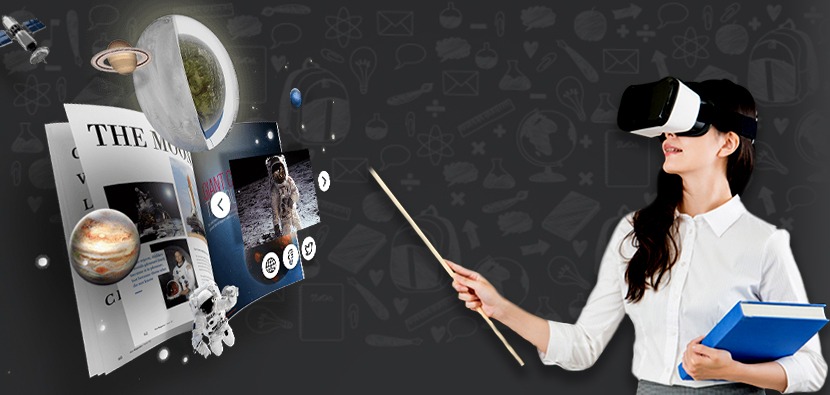In the last few years, there has been a significant technological revolution in the education sector. This sector is getting evolved with time as the latest technologies are coming into effect. Virtual reality technology is transforming the learning experience of learners as well as teachers. The use of virtual reality technology is redefining the tedious method which is increasing the student learning retention.
VR is considered as the next biggest advancement in the educational sector. Without taking much time this technology entered into modern classrooms with immersive solutions. The main reason behind is the effectiveness of using VR in the classroom.
Virtual reality in schools is changing the future prospect of education. This was only possible due to the involvement of numerous tech players in the industry. The introduction of VR solutions is opening up unexplored frontiers in the education sector.
Virtual Reality a major player in the education and technology sectors
Virtual Reality technology in education is taking the student experience to the next level. The solutions introduced in this sector is creating a future with leading advancements. VR in education certainly seems to be bright as it is one of the fastest growing trends in the market.
A broad range of engaging AR content is developed in order to help ignite to visualize the images of students. This helps the learners to retain and easily memories important educational exercises. Hence, to lead the knowledge out of the boundaries Virtual reality in classrooms comes complete with structured lesson plans. This helps learner or scholars to understand and visualize better when it comes about understanding complex educational subjects.
The most notable reasons for virtual reality in becoming a valuable element in the classroom

Advance Quality
Virtual reality has developed immersive solutions for students with a three-dimensional view of educational content. This helped in boosting the learning experience. The student can concentrate on the classroom across various disciplines with better retention. VR application with good content offers a better understanding.
Learner Involvement
The purpose of VR solutions in the field of education is actively engaging students in immersive development programs. Classrooms with VR are fascinating and more interactive. This is a simulation technology that has enabled student-teacher interactions to new levels. VR is acting as an active element to improve grades and learning experiences.
Better Retention Rates
VR technology helps students to retain the material better. The impact is due to 3D models and rendering images that help in presenting material in an interactive way. The observation and retention rate of learners is increasing after the introduction of huge potential solutions. Therefore, the users can take easily recall the content based on the visualization experience.
3D visualization
3D visualization integrated with the traditional learning method can have a massive impact on the learners. The AR material helps the students and scholars to recall hassle less. The effective results related to VR technologies have been observed. The results as expected were impressive. Moreover, the retention rate of 3D content is much impactful on the students.
Immersive classrooms
Technology has always created a significant place in the students’ experience. It has always seen that students always tried to connect with technology in many forms. Therefore, by integrating VR into the learning curriculum, students experience a seamless transition of learning. VR solutions in education, develop standard prospectus into the classroom.
Learning with Entertainment
Virtual reality has become a mainstream form of entertainment for learners. This technology is approachable as the smartphone users embrace this immersive technology. This learning method has changed the way information is passed and provided to the students.
Learning Supplement
For the learner, VR solutions act as a supplement that allows educational displays to incorporate in the traditional classroom setting. VR is a great learning tool for students to explore different realities and alternative hidden in the world. The learning experiences are high-quality with 3D visualizations that impact positively in the learning process of students.
Implementation and use cases of VR in education
The concept of 3D visualization is fruitful in every manner; likewise, virtual reality solution acts a perfect medium for learners. Therefore, immersing into 3D digital environments is a persuasive approach to learn. Interaction of the learners with VR education solutions is making it possible to experience real situations hassle less.
Famous VR Apps in education:
1. Google Expeditions
1. Google Tour Creator
2. Discovery VR
3. Apollo 11 VR HD
4. Anne Frank House VR
5. In Mind VR
6. HoloLab Champions
7. Sites In 3D
8. Nefertari: Journey to Eternity
9. Nanome
10. Becoming Homeless
How to develop VR Education application?
VR technology is a great way to share creative accomplishments. The VR Apps in education is bringing technology in the classroom. For more engaging learning students can visualize 360 videos and offer them a sense of execution by allowing them to explore creativity.
There are Virtual Reality app companies that offers virtual reality development services for creating VR education apps with HD visualization experiences. The intense expertise in the latest technologies results in an exclusive blend of VR solutions. The developers in VR app development use the power of Unity, Unreal Engine, and native VR SDKs to create appealing and realistic solutions. Here are some steps to ensure that the delivered result exceeds all client’s expectations.
1. Capture 360 images or video for upload
2. Author using Navigation Links & Hotspots.
3. Brand your app with LOGO
4. Publish to learners
Final thought
Technology is slowly taking over many aspects of our society. The advancements in education are as impressive after the integration of immersive technology. Till date, the education sector has been privileged to incorporate VR technology in the broadcasting of knowledge. Such advancement in this field has revolutionized the classroom environment and improved the learning experiences of the learners.
